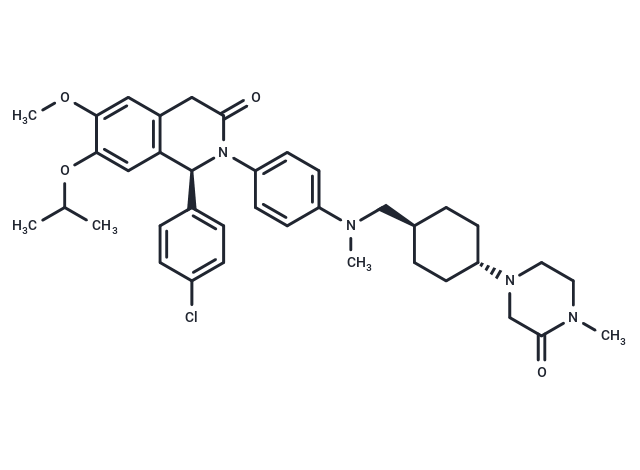Shopping Cart
- Remove All
 Your shopping cart is currently empty
Your shopping cart is currently empty

NVP-CGM097 (CGM097) is an effective and specific MDM2 inhibitor (IC50: 1.7 nM for hMDM2).

| Pack Size | Price | Availability | Quantity |
|---|---|---|---|
| 1 mg | $79 | In Stock | |
| 5 mg | $217 | In Stock | |
| 10 mg | $359 | In Stock | |
| 25 mg | $547 | In Stock | |
| 50 mg | $718 | In Stock | |
| 100 mg | $993 | In Stock | |
| 1 mL x 10 mM (in DMSO) | $316 | In Stock |
| Description | NVP-CGM097 (CGM097) is an effective and specific MDM2 inhibitor (IC50: 1.7 nM for hMDM2). |
| Targets&IC50 | MDM2:1.7 nM |
| In vitro | NVP-CGM097 binds to human MDM2(IC50: 1.7 nM) and shows high selectivity over MDM4 (IC50: 2000 nM). NVP-CGM097 is about four times more potent than Nutlin-3a (IC50: 8 nM). NVP-CGM097 significantly inhibits the proliferation of cells expressing wild-type p53, while sparing the p53 null cells with a 35-58-fold difference. NVP-CGM097 is able to significantly redistribute wild-type p53 into the cell nucleus with an IC50 of 0.224 μM. NVP-CGM097 significantly inhibits the proliferation of cells expressing wild-type p53, while sparing the p53 null cells with a 35-58-fold difference. NVP-CGM097 inhibits HCT116 (p53WT/WT, IC50: 454±136 nM). |
| In vivo | p21 mRNA levels are found to increase concomitantly with levels of NVP-CGM097 in tumor-bearing rats dosed at 30 mg/kg. The PD response is biphasic and prolonged up to 24 h. Additional p53 target genes such as MDM2 and PUMA mRNA levels are assessed in the tumor samples as well and showed similar behavior. Daily treatment with NVP-CGM097 dose-dependently and significantly inhibits SJSA-1 tumor growth in rats. It promotes stable disease at 20 mg/kg, which is associated with a plasma AUC0-24 of 163 μM?h. After iv administration, the total blood clearance (CL) of NVP-CGM097 is 5 mL/min per kg for mouse, 7 mL/min per kg for rat, 3 mL/min per kg for dog, and 4 mL/min per kg for monkey. The apparent terminal half-life (t1/2) is long in rodents and monkey (6-12 h) but is comparatively longer in dogs (20 h). After oral dosing, NVP-CGM097 is well absorbed with Tmax occurring between 1 and 4.5 h in all species tested. |
| Cell Research | Two pairs of cell lines are used to assess NVP-CGM097 p53-dependent antiproliferative effects: (1) an isogenic pair of HCT116 cell lines either expressing wild-type p53 or knocked-out for the p53 gene and (2) a nonisogenic pair of osteosarcoma cell lines either endogenously expressing wild-type p53 and amplified for MDM2 (SJSA-1 cells) or null for p53 (SAOS-2 cells). |
| Animal Research | Female athymic rats bearing subcutaneous xenotransplants of SJSA-1 tumors (n=5-12) are treated at 5, 10, 20, or 30 mg/kg or three times a week on Monday, Wednesday, and Friday (3qw M, W, F) at 30 or 70 mg/kg p.o for 14 days. Plasma AUCs are determined at the end of the study. Positive numbers indicate the percentage of tumor growth inhibition (T/C); negative numbers indicate the percentage of tumor regression. |
| Alias | CGM097 |
| Molecular Weight | 659.26 |
| Formula | C38H47ClN4O4 |
| Cas No. | 1313363-54-0 |
| Smiles | COc1cc2CC(=O)N([C@@H](c3ccc(Cl)cc3)c2cc1OC(C)C)c1ccc(cc1)N(C)C[C@H]1CC[C@@H](CC1)N1CCN(C)C(=O)C1 |
| Relative Density. | 1.210 g/cm3 (Predicted) |
| Storage | Powder: -20°C for 3 years | In solvent: -80°C for 1 year | Shipping with blue ice. | ||||||||||||||||||||||||||||||
| Solubility Information | DMSO: 48 mg/mL (72.81 mM ) H2O: Insoluble | ||||||||||||||||||||||||||||||
Solution Preparation Table | |||||||||||||||||||||||||||||||
DMSO
| |||||||||||||||||||||||||||||||

Copyright © 2015-2024 TargetMol Chemicals Inc. All Rights Reserved.